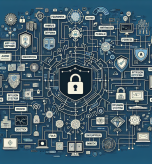As required by the digital environment today, strong cyber security must be present for organizations in Australia. Hence, they have to deal with different threats’ complexities; thus, small enterprises up to big corporations have to strengthen their security measures. Protection of sensitive data and maintaining business continuity is the two most important factors. The Essential-8 security framework released by Australian Signals Directorate (ASD) provides an excellent approach towards improving the cyber posture of any organisation. It stipulates clear maturity levels that can be utilized to mitigate effectively the risks associated with a cyber attack. Prevention, detection, and response are the three pillars upon which this framework revolves that can help any organization build its resilience against cyber threats. This write-up will discuss how fortifying your organizational defenses by implementing ASD-8 Framework can pave a way towards a secure digital future.
Importance of Cyber Security for Australian Organisations
As digital transformation unfolds, Australian organisations face unique cyber security challenges. Lets look at the current cyber landscape and introduce the Essential-8 framework as a major tool for improving security measures.
Understanding the Australian Cyber Security Landscape
Cyber threats are evolving in Australia, becoming more sophisticated and frequent. Every size organisation is a potential target, making necessary strong security. Recent statistics have shown an increase in the number of cyber attacks against Australian businesses, involving ransomware and phishing assaults to sophisticated, intentional attacks on vital infrastructure.
Cyber breaches are not only costly financially but also damage their reputation, customer trust, and operational continuity. Therefore understanding and managing this landscape is important to be resilient.
What the Essential-8 Security Framework does
The Essential-8 security framework provides a comprehensive approach to cybersecurity. It describes eight key strategies to reduce security incidents.
These strategies target three main areas: preventing malware, limiting incidents, and recovering data and systems. Implementing these strategies can significantly improve security posture.
Its adaptability makes it applicable to a wide range of organizations and benefiting businesses large and small across Australia.
Improving Organisation Security posture with the ASD-8 Framework
The ASD-8 framework provides a structured approach to improving organizational cybersecurity. This section explores its maturity levels and effective preventive measures.
Organisation Maturity Levels Explained
The ASD-8 framework defines four maturity levels for each of the eight strategies and supports organizations in improving security:
- Maturity Level 0: Minimal or no policy implementation.
- Maturity Level 1: Basic cyber hygiene is established.
- Maturity Level 2: More comprehensive security controls are implemented.
- Maturity Level 3: The objectives of risk mitigation strategies are fully met.
Companies complete these stages by implementing more advanced security measures and practices.
The maturity model supports continuous improvement and enables organizations to effectively prioritize and plan security updates.
Effective Strategies for Preventing Cyber Attacks
Fighting cyberattacks requires effective prevention. The Essential 8 framework suggests the following key approaches:
- Use application whitelisting to block unauthorized programs.
- Patch applications to fix known vulnerabilities.
- Set Microsoft Office macro settings to restrict untrusted macros.
- Harden user applications to reduce vulnerabilities.
- Proper implementation of these strategies reduces the risk of attack.
- Employee training and awareness programs complement these technical measures and establish a comprehensive approach to preventing cyberattacks.
Strengthening Detection and Response Skills
Prevention is critical, but strong detection and response are essential to a strong cybersecurity strategy. This section describes how companies can improve these important components.
Detect and Respond to Threats
Effective threat detection and response requires a multi-layered approach. The core elements are:
- Establish advanced monitoring systems to detect anomalous activity.
- Develop clear incident response protocols.
- Regularly update and review disaster recovery plans.
- The development of a Security Information and Event Management (SIEM) system is essential to consolidate and analyze security data from a variety of sources.
- Automated threat analysis provides real-time data on emerging threats, enabling faster responses.
Regular security audits and penetration testing can uncover vulnerabilities before they are exploited by cyber criminals.
Achieving Enterprise Security
Strong enterprise cybersecurity requires a combination of technology, processes, and people. The Essential-8 framework provides a solid foundation for this.
The important steps are:
- Conduct regular risk assessments to identify and prioritize security requirements.
- Implement and maintain the 8 essential policies.
- Promote a culture of security awareness within the organization.
Continuous growth is essential. Regular review and improvement of security measures is essential to address new threats.
Collaboration with industry colleagues and government agencies can provide insights and resources to strengthen cybersecurity.










